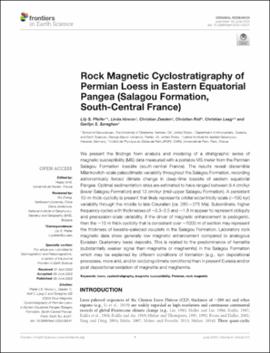| dc.contributor.author | Pfeifer, Lily S. | |
| dc.contributor.author | Hinnov, Linda | |
| dc.contributor.author | Zeeden, Christian | |
| dc.contributor.author | Rolf, Christian | |
| dc.contributor.author | Laag, Christian | |
| dc.contributor.author | Soreghan, Gerilyn S. | |
| dc.date.accessioned | 2021-11-12T14:18:58Z | |
| dc.date.available | 2021-11-12T14:18:58Z | |
| dc.date.issued | 2020-06-26 | |
| dc.identifier.citation | Pfeifer LS, Hinnov L, Zeeden C, Rolf C, Laag C and Soreghan GS (2020) Rock Magnetic Cyclostratigraphy of Permian Loess in Eastern Equatorial Pangea (Salagou Formation, South-Central France). Front. Earth Sci. 8:241. doi: 10.3389/feart.2020.00241 | en_US |
| dc.identifier.uri | https://hdl.handle.net/11244/331243 | |
| dc.description.abstract | We present the findings from analysis and modeling of a stratigraphic series of magnetic susceptibility (MS) data measured with a portable MS meter from the Permian Salagou Formation loessite (south-central France). The results reveal discernible Milankovitch-scale paleoclimatic variability throughout the Salagou Formation, recording astronomically forced climate change in deep-time loessite of eastern equatorial Pangea. Optimal sedimentation rates are estimated to have ranged between 9.4 cm/kyr (lower Salagou Formation) and 13 cm/kyr (mid-upper Salagou Formation). A persistent 10-m-thick cyclicity is present that likely represents orbital eccentricity-scale (∼100 kyr) variability through the middle to late Cisuralian (ca. 285—275 Ma). Subordinate, higher frequency cycles with thicknesses of ∼3.3–3.5 and ∼1.8 m appear to represent obliquity and precession-scale variability. If the driver of magnetic enhancement is pedogenic, then the ∼10 m thick cyclicity that is consistent over ∼1000 m of section may represent the thickness of loessite–paleosol couplets in the Salagou Formation. Laboratory rock magnetic data show generally low magnetic enhancement compared to analogous Eurasian Quaternary loess deposits. This is related to the predominance of hematite (substantially weaker signal than magnetite or maghemite) in the Salagou Formation which may be explained by different conditions of formation (e.g., syn depositional processes, more arid, and/or oxidizing climate conditions) than in present Eurasia and/or post depositional oxidation of magnetite and maghemite. | en_US |
| dc.description.sponsorship | This work was supported by the National Science Foundation under International Research Experiences for Students (IRES) grant OISE-1658614 (PIs GS, M. J. Soreghan) and also EAR-1338331 (Sedimentary Geology and Paleobiology Program to GS). | en_US |
| dc.language | en_US | en_US |
| dc.rights | Attribution 4.0 International | * |
| dc.rights.uri | https://creativecommons.org/licenses/by/4.0/ | * |
| dc.subject | loess | en_US |
| dc.subject | cyclostratigraphy | en_US |
| dc.subject | magnetic susceptibility | en_US |
| dc.subject | Permian | en_US |
| dc.subject | rock magnetic | en_US |
| dc.title | Rock Magnetic Cyclostratigraphy of Permian Loess in Eastern Equatorial Pangea (Salagou Formation, South-Central France) | en_US |
| dc.type | Article | en_US |
| dc.description.peerreview | Yes | en_US |
| dc.identifier.doi | 10.3389/feart.2020.00241 | en_US |
| ou.group | Mewbourne College of Earth and Energy::School of Geosciences | en_US |

